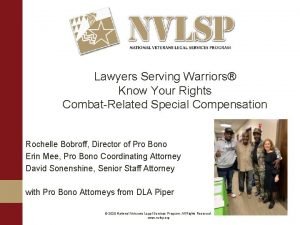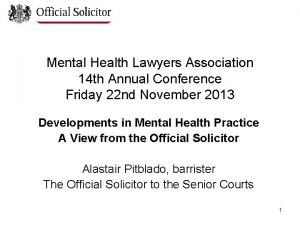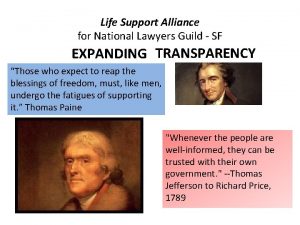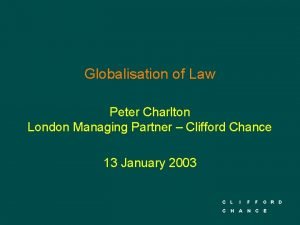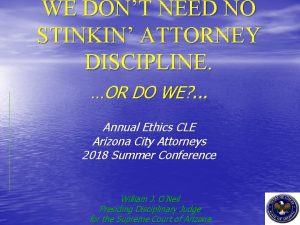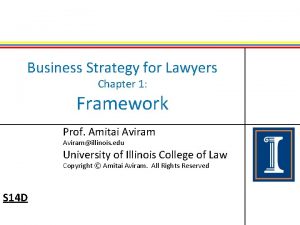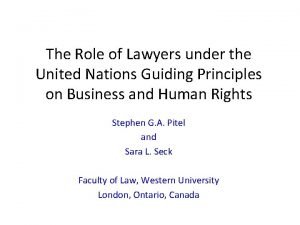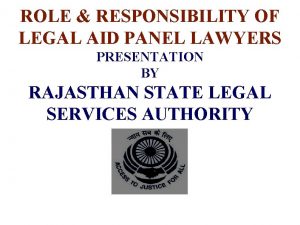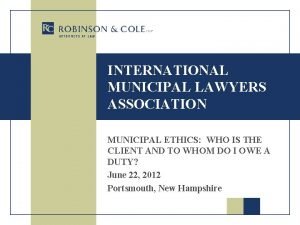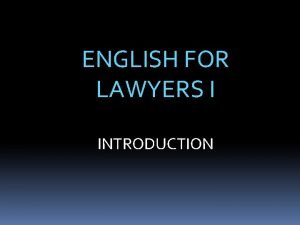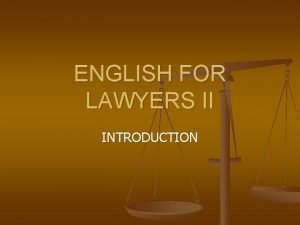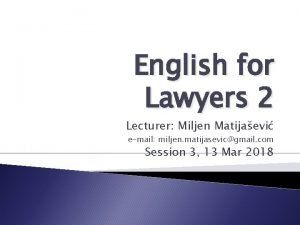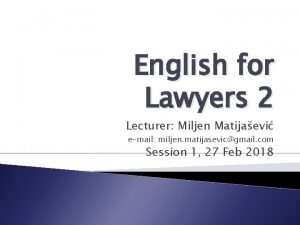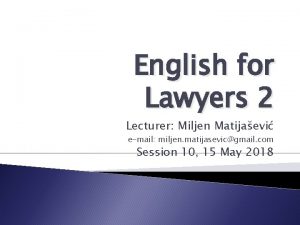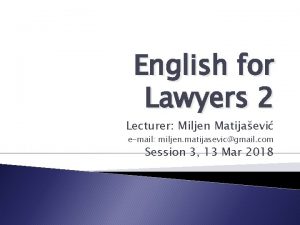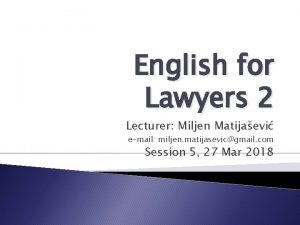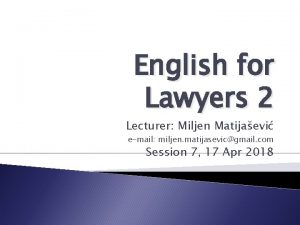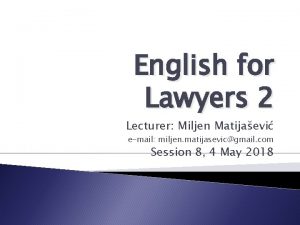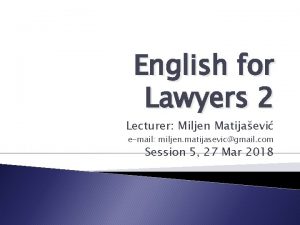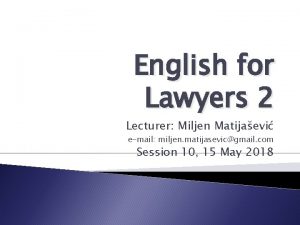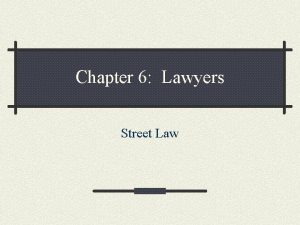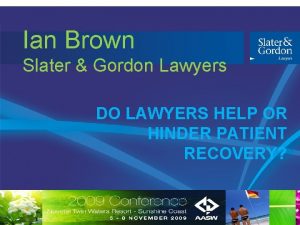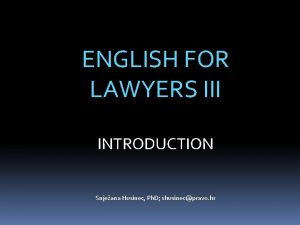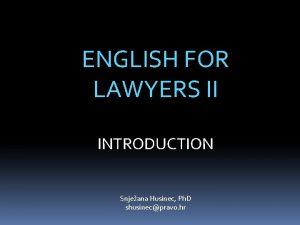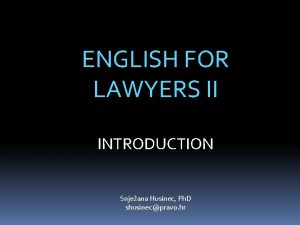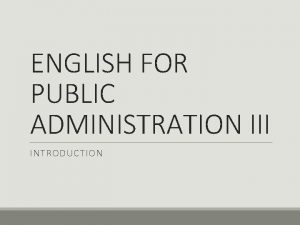ENGLISH FOR LAWYERS I INTRODUCTION Lecturer Prof dr






































- Slides: 38

ENGLISH FOR LAWYERS I INTRODUCTION

Lecturer Prof. dr. sc. Lelija Sočanac Office hours: Tuesday, 16. 00 – 17. 00 h, Gundulićeva 10, Office 5 E-mail: lelijasocanac@gmail. com

Textbook: Sočanac, L. ; Matijašević, M; JavornikČubrić, M; Husinec, S; Horvatić-Bilić, I. English for the Legal Profession. Zagreb: Narodne novine, 2017.

Additional teaching materials Foreign Language Department’s web page: Ppt presentations Additional materials

General Dictionaries Bujas, Željko, Veliki hrvatsko-engleski rječnik. - Zagreb: Nakladni zavod Globus, 1999 Bujas, Željko, Veliki englesko-hrvatski rječnik. - Zagreb : Nakladni zavod Globus, Advanced Learner’s Dictionaries (Collins Cobuild, Oxford, Longman)

Online dictionaries www. eudict. com glosbe. com

English-Croatian Law Dictionaries Gačić, M. Englesko-hrvatski rječnik prava i međunarodnih poslovnih odnosa = English-Croatian Dictionary of Law and International and Business Relations. Zagreb: Školska knjiga, 2010.

English Law Dictionaries Black's Law Dictionary / ed. Bryan A. Garner. Thomson West, 2004. Collin, P. H. , Dictionary of Law. - London : Bloomsbury, 2004 Osborn’s Concise Law Dictionary. - Sweet and Maxwell, 2001 Oxford Dictionary of Law / ed. Martin, E. A. ; Law, J. . Oxford University Press, 2006.

ENGLISH FOR LAWYERS: Structure of the Textbook 4 modules corresponding to 4 semesters (English for Lawyers I – IV) Each module: 6 units Each unit: 2 -3 parts Part One: Introduction to a topic, Part Two: Additional reading, original texts) Annexes: Presentation Skills (p. 267), Academic Writing (p. 271), Glossary of key terms and concepts (p. 275), English-Croatian glossary (311)

PROGRAMME AND TIMETABLE: ENGLISH I MONDAY 12. 00 -13. 30 TRH 14, Lecture room II 1 Oct. Introduction 8 Oct. UNIT 1. Language and Law I 15 Oct. UNIT 1. Language and Law II 22 Oct. UNIT 2. About Law I 29 Oct. UNIT 2. About Law II 5 Nov. UNIT 3. Branches of Law I 19 Nov. Unit 3. Branches of Law II

PROGRAMME AND TIMETABLE ENGLISH I MONDAY 12. 00 – 13. 30, TRH 14, Lecture room II 26 Nov. UNIT 4: Preliminary exam 3 Dec. UNIT 4: The Historical Development of Law 10 Dec. UNIT 5. Legal Systems of the World I 17 Dec. UNIT 5: Legal Systems of the World II 7 Jan. UNIT 6: State Governance and Administration of Justice I 14 Jan. UNIT 6: State Governance and Administration of Justice II 21 Jan. Preliminary exam

COURSE REQUIREMENTS 75% attendance Prepare for each class: self study; home assignments Active participation in class Don’t hesitate to ask questions!

Assessment 75% attendance entitles you to take preliminary exams (written+oral) If you give a good presentation on a selected topic, you don’t have to take the oral exam If you pass the preliminary exams, you don’t have to take the exam at the end of the semester

Presentations: Suggested Topics Law and language, Legal English Theory of law: Law and ideology; Law and morality; Law and justice; Law and religion; Classification of law (any branch of law) History of law; Roman law Legal systems of the world; Civil law; Common law; Other legal traditions Separation of powers; Resolving disputes

PREPARING YOUR SEMINAR PAPER 1. Choose a topic 2. Research: collect as much material as you can 3. Organize your materials 4. Structure your paper: ◦ 1. Introduction ◦ 2. Elaboration ◦ 3. Conclusion ◦ References

STRUCTURE Name TITLE Abstract (A short summary of what you are going to write about) 1. Introduction. 1. 1. Definition 1. 2. Historical Background/Theoretic. Background/Problem 2. The main argument 3. Conclusion References: Oakland, John (2000), British Civilization : an Introduction. - 4 th ed. London; New York : Routledge.

Academic style Formal Impersonal Full forms should be used instead of contracted ones (e. g. cannot instead of can’t) Avoid making false or personal claims Allow for other points of view Use appropriate vocabulary: legal terms Avoid colloquialisms Must be grammatically correct

Quoting “If the question is asked: ‘what is the role of law in society? ’ a common response would be ‘to maintain order”. (Partington 2006: 13) References Partington, Martin. 2006. An Introduction to the English Legal System. 3 rd ed. Oxford University Press.

PARAGRAPHING A paragraph: several sentences contained in the topic (or key) sentence The topic sentence: usually the first one, contains the main idea or topic The other sentences support it by adding further information or examples A paragraph should link logically with previous and following paragraphs

Paragraphing: Exercise A) It is mainly formal, impersonal and objective. B) In most of these the writer is expected to include references to other writing or research C) Academic writing is a particular kind of writing that can be recognised by its style. D) These include essays, research reports and articles, case studies, surveys, dissertations, theses, and examination papers. E) Other distinctive features will depend upon the specific types of academic writing

Referencing Name of the author year Title Place of publication Publisher Pages used

Revising and editing You should always read the text again to see if it is written clearly Check the organization of the paper Check grammar and spelling Revise

PAPERS: P-O-W-E-R Produce (something worth saying) Organize Write Edit Refine

PRESENTATION 1. Choose your topic (partly depends on your timeframe); 2. Think of your audience 3. Research: Collect your materials 4. Organize your presentation

STRUCTURE: THE BEGINNING 1. Establish contact: Greet the audience, introduce yourself (Good morning/afternoon/evening. My name is. . . I’m going to speak to you today about. . . ) 2. Make an impact – say something that will make the audience want to listen to you 3. Give a preview of the argument you are going to present

STRUCTURE: THE MIDDLE 1. Divide speech into a few manageable points (‘I’m going to make a couple of points today. Briefly, these are. . . ’ 2. Place them in a logical order 3. Demonstrate how each point contributes to the main theme of the presentation

STRUCTURE: THE END 1. Indicate that you have reached the end of your presentation (And finally. . . ; In conclusion. . . ) 2. Summarise the key points of your presentation (‘By way of summary. . . ’) 3. End with a clear statement (‘The most important effect of all this is. . . ’) 4. Invite questions

STRUCTURE: SUMMARY 1) Beginning: start by saying what you are going to talk about (“Tell them what you’re going to tell them”) 2) Middle: most important points with good illustrative examples (“Tell them”) 3) End: sum up (“Tell them again what you’ve told them”) 4) Invite questions

Points to remember 1. Use simple and clear language 2. Check and practise the pronunciation of difficult words 3. Pay attention to your intonation 4. If possible, do not read (notes, keywords) 5. Use visual aids, or write on the blackboard 6. Do not forget about your TIMING!!! (15 min. )

CHECKLIST: Preparation Consider your audience: 1. What are they interested in? 2. What do they need to know? 3. What is the best way of presenting it?

Power Point 1. Check the equipment 2. DO NOT put too much text on a slide (no more than 6 lines) 3. Text large enough for everyone to see 4. Be careful about background colours and pictures

Throughout 1. Project your voice so that everyone can hear you 2. Maintain eye contact with your audience 3. Use visual aids to illustrate your points 4. Use simple and clear language 5. Eliminate anything not essential to the points you are making

Team presentations (3 members) 1. Choose who will lead the presentation 2. Divide your topics 3. Rehearse how each person will hand over to the next 4. Identify what each person will be doing while another is speaking

PRESENTATIONS: KISS Keep It Short and Simple

A few quotations… Writing is the hardest way of earning a living, with the posible exception of wrestling alligators. (Olin Miller) It usually takes me more than three weeks to prepare a good spontaneus speech. (Mark Twain)

STUDENT-MENTORS If your English is good enough, you can help your colleagues on a regular basis (1 session a week) If you have problems with your English, contact a student mentor at the beginning of the academic year (web page)

Tempus reading room TMT 3 (basement) Opening hours: Monday – Friday 10. 0014. 00 h

Assignment Have a look at any Act of Parliament. Focus on its language and structure. What do you notice? Does legal language differ from ordinary language? How? https: //www. legislation. gov. uk/2018
 Lecturer's name
Lecturer's name Jeannie watkins
Jeannie watkins Spe distinguished lecturer
Spe distinguished lecturer Teacher good morning class
Teacher good morning class Photography lecturer
Photography lecturer Lecturer in charge
Lecturer in charge Designation lecturer
Designation lecturer Designation of lecturer
Designation of lecturer Why himalayan rivers are pernnial in nature
Why himalayan rivers are pernnial in nature Lecturer name
Lecturer name Pearson lecturer resources
Pearson lecturer resources Spe distinguished lecturer
Spe distinguished lecturer Lector vs lecturer
Lector vs lecturer Lecturer in charge
Lecturer in charge Cfa lecturer handbook
Cfa lecturer handbook Lecturer asad ali
Lecturer asad ali Going concern
Going concern Crsc lawyers
Crsc lawyers Vermont association of criminal defense lawyers
Vermont association of criminal defense lawyers Mental health lawyers association
Mental health lawyers association Life support alliance
Life support alliance Immigration lawyers charlton
Immigration lawyers charlton Premium digital marketing for lawyers
Premium digital marketing for lawyers Lawyers oath
Lawyers oath Southeast asia customs lawyers
Southeast asia customs lawyers Pro bono lawyers in alabama
Pro bono lawyers in alabama Business strategy for lawyers
Business strategy for lawyers United nations basic principles on the role of lawyers
United nations basic principles on the role of lawyers Brownsville lhwca attorney
Brownsville lhwca attorney Legal aid panel
Legal aid panel International municipal lawyers association
International municipal lawyers association Sports lawyers in india
Sports lawyers in india International association of korean lawyers
International association of korean lawyers Progress lawyers
Progress lawyers Sujet posé exemple
Sujet posé exemple Kontinuitetshantering
Kontinuitetshantering Typiska novell drag
Typiska novell drag Nationell inriktning för artificiell intelligens
Nationell inriktning för artificiell intelligens Returpilarna
Returpilarna

















